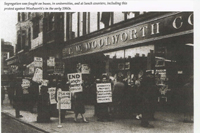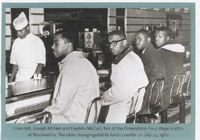For many years our goal in exploring the Sit-In Movement was for students to understand the motives, strategies and commitment of those students who sat in at lunch counters to end segregation. We stressed resistance, collaboration, perseverance and nonviolence. We acknowledged the segregationists who harassed the students, but they were never our focus. We never considered the workers until our students brought them to our attention.
Documentation Examples > Examples of documentation to aid teachers' own reflections
I Want to Help You But... Students and Teachers Uncover the Workers' Dilemma During the Sit-In Movement
School: Ezra H. Baker and John Simpkins Schools, Dennis-Yarmouth, MA
1. Another Perspective
- February 1, 1960 - Greensboro, North Carolina - Four students from the North Carolina A&T sit in at the Woolworth's lunch counter
- "In a week the Greensboro Four had grown to hundreds. Within two months protests had taken place in 125 cities in nine states." (A Dream of Freedom by Diane McWhorter)
- The students and their supporters were determined to end lunch counter segregation through massive and prolonged resistance. They recognized that their actions undermined the economic base of the community.
- The segregationists, especially those who harassed the students, were determined to keep the lunch counters segregated.
- The men and women, both black and white, who worked behind lunch counters in low paying jobs were expected to refuse service to the students sitting in regardless of their personal feelings.
Once we began documenting our study of the Sit-In Movement, we noticed that our students were interested in the workers and what part they played in the story. We began to adapt our curriculum in order to give our students access to the plight of the workers. This panel demonstrates our evolving understanding of how considering the workers' role could lead our students to a deeper understanding of the institutional nature of racism.



